Click on images to enlarge
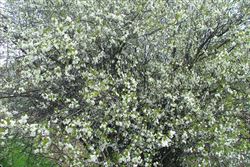
infestation (Photo: Sheldon Navie)
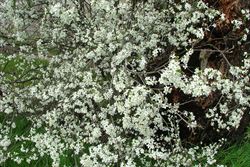
habit in flower in spring (Photo: Sheldon Navie)
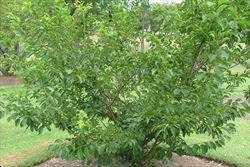
habit with leaves in summer (Photo: Sheldon Navie)
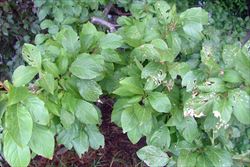
mature leaves (Photo: Sheldon Navie)
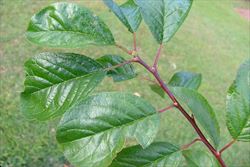
young stem and dark green mature leaves (Photo: Sheldon Navie)
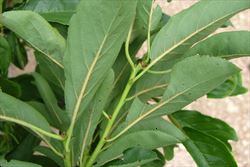
close-up of leaf undersides (Photo: Sheldon Navie)
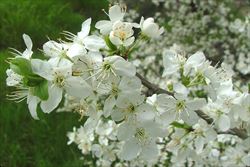
white flowers and light green young leaves (Photo: Sheldon Navie)
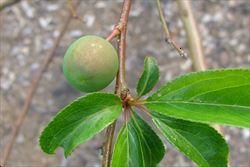
immature fruit (Photo: Sheldon Navie)
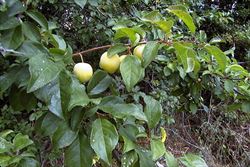
yellow mature fruit (Photo: Jackie Miles and Max Campbell)
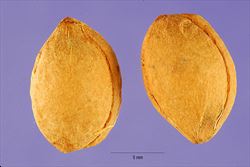
close-up of seeds (Photo: Tracey Slotta at USDA PLANTS Database)
Scientific Name
Prunus cerasifera Ehrh.
Synonyms
Prunus cerasifera Ehrh. var. atropurpurea H. JaegerPrunus cerasifera Ehrh. var. pissardii (Carrière) L.H. Bailey
Family
Amygdalaceae (New South Wales)Rosaceae (Queensland, the ACT, Victoria, South Australia, Tasmania and Western Australia)
Common Names
cherry plum, cherry plum tree, cherry-plum, myrobalan, myrobalan plum, purple leaf cherry plum, purple leaf cherryplum, purple leafed plum, purple-leaf plum, purple-leafed cherry plum, purple-leafed plum, purple-leaved plum, thundercloud cherry, wild cherry plum
Origin
Native to south-eastern Europe (i.e. Albania, Bulgaria, Greece and Yugoslavia), western Asia (i.e. Afghanistan, Iran, Iraq, Turkey, Armenia, Azerbaijan, Georgia, southern Russia, Kyrgyzstan, Tajikistan and Turkmenistan), western China and Pakistan.
Cultivation
Cherry plum (Prunus cerasifera) has been widely cultivated as a garden ornamental and street tree in the temperate regions of Australia. Various purple-leaved cultivars are also very popular in cultivation (e.g. Prunus cerasifera 'Nigra', Prunus cerasifera 'Atropurpurea' and Prunus cerasifera 'Pissardii').
Naturalised Distribution
Widely naturalised in southern Australia (i.e. naturalised in eastern New South Wales, in the ACT, Victoria, south-eastern and eastern South Australia, and the coastal districts of south-western Western Australia). Possibly also naturalised in Tasmania.
Naturalised elsewhere in Europe, tropical Asia, New Zealand and the USA.
Habitat
A weed of riparian vegetation, open woodlands, disturbed sites, waste areas and roadsides in the temperate regions of Australia.
Habit
A large shrub or small tree growing up to 12 m tall, which loses its leaves during winter (i.e. it is deciduous).
Distinguishing Features
- a large shrub or small tree that loses its leaves during winter.
- its alternately arranged leaves may be green or various shades of red or purple.
- these leaves (2-6 cm long and 1-3 cm wide) have sharply-toothed to almost entire margins.
- its white or pink flowers (about 2.5 cm across) are borne singly or in small clusters.
- its fleshy yellow or reddish fruit (15-25 mm across) have a stony centre and resemble a cherry.
Stems and Leaves
The lower stems are sometimes spiny, while the upper stems are usually spineless. Younger stems are initially sparsely hairy but soon become hairless (i.e. glabrescent)
The alternately arranged leaves are borne on stalks (i.e. petioles) 5-15 mm long. These leaves (2-6 cm long and 1-3 cm wide) are egg-shaped in outline (i.e. ovate or obovate) with sharply-toothed (i.e. serrate) or almost entire margins and pointed tops (i.e. acute apices). They are hairless (i.e. glabrous), except for a few hairs along the veins on their undersides. The leaves may be either green or various shades of red or purple, depending on which cultivar they are from.
Flowers and Fruit
The flowers are borne singly or in small clusters on very short side branches. These flowers (about 2.5 cm across) are white, or occasionally pink, and are borne on slender stalks (i.e. pedicels) 1-3 cm long. Each flower has five rounded sepals and five petals. They also have numerous stamens and an ovary topped with a style and stigma. Flowering occurs during early spring (i.e. during August and September), before or with the new leaves.
The fleshy fruit (15-25 mm across) are rounded in shape (i.e. globose or sub-globose) and turn from green to yellow or reddish in colour as they mature. They have a stony centre (i.e. they are drupes) and resemble a cherry.
Reproduction and Dispersal
This species reproduces mainly by seed, which are mainly dispersed by animals that eat the fruit. Seeds may also be dispersed in dumped garden waste.
Environmental Impact
Cherry plum (Prunus cerasifera) is regarded as an environmental weed in Victoria, South Australia, the ACT and New South Wales.
Legislation
Not declared or considered noxious by any state government authorities.
Similar Species
Cherry plum (Prunus cerasifera) can be confused with sour cherry (Prunus cerasus), plum (Prunus domestica), cherry (Prunus avium ), apricot (Prunus armeniaca), almond (Prunus dulcis), peach (Prunus persica var. persica) and nectaine (Prunus persica var. nucipersica) trees. These species can be distinguished by the following differences:
-
cherry plum (Prunus cerasifera ) has egg-shaped (i.e. ovate or obovate) leaves with entire to sharply-toothed (i.e. serrate) margins. Its white or pinkish flowers are borne on stalks (i.e. petioles) 1-3 cm long. Its relatively small fleshy fruit (1.5-2.5 cm across) turn yellow or red in colour when mature and are hairless (i.e. glabrous).
-
sour cherry (Prunus cerasus) has egg-shaped (i.e. ovate or obovate) leaves with doubly-toothed (i.e. serrate) margins. Its white or pinkish flowers are borne on stalks (i.e. petioles) 1-3.5 cm long. Its small fleshy fruit (about 1.5 cm across) turn red in colour when mature and are hairless (i.e. glabrous).
-
plum (Prunus domestica) has oval to egg-shaped (i.e. elliptic to obovate) leaves with toothed (i.e. crenate or serrate) margins. Its white flowers are borne on stalks (i.e. petioles) 0.5-2 cm long. Its relatively large fleshy fruit (2-5 cm across) turn red or purplish in colour when mature and are hairless (i.e. glabrous).
-
cherry (Prunus avium) has oval to egg-shaped (i.e. elliptic to obovate) leaves with toothed (i.e. crenate or serrate) margins. Its white or pinkish flowers are borne on long stalks (i.e. petioles) 2-5 cm long. Its small fleshy fruit (1.5-2.5 cm across) turn bright or dark red in colour when mature and are hairless (i.e. glabrous).
-
apricot (Prunus armeniaca) has relatively relatively broad to heart-shaped (i.e. cordate) leaves with entire to sharply-toothed (i.e. serrate) margins. Its white or pinkish flowers are almost stlakless (i.e. sessile). Its relatively large fleshy fruit (3-5 cm across) turn orange in colour when mature and are softly velvety hairy (i.e. minutely pubescent).
-
almond (Prunus dulcis) has relatively narrow (i.e. lanceolate to narrowly-elliptic) leaves with finely-toothed (i.e. crenulate or serrulate) margins. Its white or pinkish flowers are almost stlakless (i.e. sessile). Its relatively large fruit (2-7 cm across) and are not fleshy and are softly velvety hairy (i.e. minutely pubescent).
-
peach (Prunus persica var. persica) has relatively narrow (i.e. lanceolate to lanceolate-oblong) leaves with entire to sharply-toothed (i.e. serrate) margins. Its white, pink or red flowers are almost stlakless (i.e. sessile). Its relatively large fleshy fruit (3-5 cm across) turn yellow to red in colour when mature and are softly velvety hairy (i.e. minutely pubescent).
-
nectarine (Prunus persica var. nucipersica) has relatively narrow (i.e. lanceolate to lanceolate-oblong) leaves with entire to sharply-toothed (i.e. serrate) margins. Its white, pink or red flowers are almost stlakless (i.e. sessile). Its relatively large fleshy fruit (3-5 cm across) turn yellow to red in colour when mature and are hairless (i.e. glabrous).

